Model Experimental Study on De-Icing Method of Bridge Pylon Beam Based on Electric Heating
Abstract
1. Introduction
2. Model Test Design
2.1. Principal Idea of Tests
- (1)
- The icing characteristics (ice distribution and icing features) of the beam are obtained through pre-tests of the icing. By learning the ice distribution, a suitable de-icing area is selected. Subsequently, the growth rule of the icicles is assessed by analyzing the length, diameter, and tilt angle of the icicles, and finally, the reliability and stability of the test conditions are verified by comparing them with the established icing literature.
- (2)
- The heating system is installed at the selected area, and the anti-icing tests are carried out; these tests focus on recording the temperature change and the ice coverage of the heating system surface during the anti-icing process. The test results are analyzed to find the critical anti-icing temperature of the heating system and to give the recommended pre-heating time, a suggested environmental range for the heating system, and an alternative optimized compensation scheme.
- (3)
- Passive de-icing tests are carried out to obtain the de-icing time under different ice thicknesses. Subsequently, the passive de-icing of the heating system for the beams is evaluated qualitatively and quantitatively by comparing the relevant de-icing literature. The technical route is shown in Figure 2.
2.2. Test System and Working Relationships
- (1)
- The spray system
- (2)
- The wind delivery system
- (3)
- The heating system
- (4)
- The monitor system
- (5)
- The data acquisition system
- (6)
- Other equipment or models
2.3. Test Procedure
2.3.1. Icing Tests
2.3.2. Anti-Icing Tests
2.4. Test Materials
2.4.1. Carbon Fiber Heating Cable (CFHC)
2.4.2. Stainless Steel Module and Heat-Insulated Film
2.4.3. Thermocouples
2.5. Design Idea of the Heating System
3. Pre-Tests of Icing and Analysis of Results
3.1. Icing Distribution
3.2. Icing Features
4. Results and Analysis of De-Icing Tests
4.1. Anti-Icing Tests
4.1.1. Critical Anti-Icing Temperature
4.1.2. Suggested Pre-Heating Time
4.1.3. Suggested Environment Range of Application
4.1.4. Compensation Scheme
4.2. Passive De-Icing Tests
4.2.1. Passive De-Icing Evaluation
4.2.2. Energy Requirement
5. Conclusions
- (1)
- By pre-heating the novel heating system for a certain time, the surface of the beam can be prevented from freezing. Compared with the passive de-icing method, the pre-heating anti-icing method is more efficient and safer and is more suitable for bridge pylon beam de-icing.
- (2)
- The short pre-heating time will lead to icing in some areas of the novel heating system, and a longer pre-heating time will cause energy waste. When the pre-heating time exceeds 7 min, the entire anti-icing process can be ice-free.
- (3)
- When the wind velocity increases to 5 m/s, it is safer to shut down the novel heating system and use the passive de-icing method at the end of icing.
- (4)
- The time required to complete the de-icing is independent of the amount of icing, and the de-icing can be completed within 1 h. Combined with traffic control, the passive de-icing method can also achieve the purpose of eliminating the hidden danger of beam icing.
Author Contributions
Funding
Data Availability Statement
Conflicts of Interest
References
- Yang, Z.Y.; Zhan, X.; Zhou, X.L.; Xiao, H.L.; Pei, Y.Y. The Icing Distribution Characteristics Research of Tower Cross Beam of Long-Span Bridge by Numerical Simulation. Energies 2021, 14, 5584. [Google Scholar] [CrossRef]
- Yiqiu, T.; Chi, Z.; Huijie, L.; Hao, S.; Huining, X. Experimental and numerical analysis of the critical heating strategy for hydronic heated snow melting airfield runway. Appl. Therm. Eng. 2020, 178, 115508. [Google Scholar] [CrossRef]
- Mirzanamadi, R.; Hagentoft, C.E.; Johansson, P. An analysis of hydronic heating pavement to optimize the required energy for anti-icing. Appl. Therm. Eng. 2018, 144, 278–290. [Google Scholar] [CrossRef]
- Liu, K.; Dai, D.; Fu, C.; Li, W.; Li, S. Structural investigation of the snow-melting heated bridge deck based on the thermal field distribution. Appl. Therm. Eng. 2019, 161, 114132. [Google Scholar] [CrossRef]
- Ozsoy, A.; Yildirim, R. Prevention of icing with ground source heat pipe: A theoretical analysis for Turkey’s climatic conditions. Cold. Reg. Sci. Technol. 2016, 125, 65–71. [Google Scholar] [CrossRef]
- Wang, X.; Zhu, Y.; Zhu, M.; Zhu, Y.; Fan, H.; Wang, Y. Thermal analysis and optimization of an ice and snow melting system using geotherm by super-long flexible heat pipes. Appl. Therm. Eng. 2017, 112, 1353–1363. [Google Scholar] [CrossRef]
- Tuan, Y. Roca Spur Bridge: The Implementation of an Innovative Deicing Technology. J. Cold. Reg. Eng. 2008, 22, 1–15. [Google Scholar] [CrossRef]
- Sassani, A.; Arabzadeh, A.; Ceylan, H.; Kim, S.; Sadati, S.M.S.; Gopalakrishnan, K.; Taylor, P.C.; Abdualla, H. Carbon Fiber-based Electrically Conductive Concrete for Salt-free Deicing of Pavements. J. Clean. Prod. 2018, 203, 799–809. [Google Scholar] [CrossRef]
- Mohammed, A.G.; Ozgur, G.; Sevkat, E. Electrical resistance heating for deicing and snow melting applications: Experimental study. Cold. Reg. Sci. Technol. 2019, 160, 128–138. [Google Scholar] [CrossRef]
- Kim, H.S.; Ban, H.; Park, W.J. Deicing Concrete Pavements and Roads with Carbon Nanotubes (CNTs) as Heating Elements. Materials 2020, 13, 2504. [Google Scholar] [CrossRef]
- Malakooti, A.; Theh, W.S.; Sadati, S.M.S.; Ceylan, H.; Kim, S.; Mina, M.; Cetin, K.; Taylor, P.C. Design and Full-scale Implementation of the Largest Operational Electrically Conductive Concrete Heated Pavement System. Constr. Build. Mater. 2020, 255, 119229. [Google Scholar] [CrossRef]
- Liu, X.; Rees, S.J.; Spitler, J.D. Modeling snow melting on heated pavement surfaces. Part II: Experimental validation. Appl. Therm. Eng. 2007, 27, 1125–1131. [Google Scholar] [CrossRef]
- Liu, K.; Huang, S.; Xie, H.; Wang, F. Multi-objective optimization of the design and operation for snow-melting pavement with electric heating pipes. Appl. Therm. Eng. 2017, 122, 359–367. [Google Scholar] [CrossRef]
- Zhao, H.; Wu, Z.; Wang, S.; Zheng, J.; Che, G. Concrete pavement deicing with carbon fiber heating wires. Cold. Reg. Sci. Technol. 2011, 65, 413–420. [Google Scholar] [CrossRef]
- Poots, G.; Rodgers, G.G. The Icing of a Cable. IMA J. Appl. Math. 1976, 18, 203–217. [Google Scholar] [CrossRef]
- Makkonen, L.; Oleskiw, M.M. Small-scale experiments on rime icing. Cold. Reg. Sci. Technol. 1997, 25, 173–182. [Google Scholar] [CrossRef]
- Kollár, L.E.; Farzaneh, M. Wind-tunnel investigation of icing of an inclined cylinder. Int. J. Heat. Mass. Tran. 2010, 53, 849–861. [Google Scholar] [CrossRef]
- Launiainen, J.; Lyyra, M. Icing on a non-rotating cylinder under conditions of high liquid water content in the air: I. Form and size of ice deposits. J. Glaciol. 1986, 32, 6–11. [Google Scholar] [CrossRef]
- Maeno, N.; Makkonen, L.; Nishimura, K.; Kosugi, K.; Takahashi, T. Growth rates of icicles. J. Glaciol. 1994, 40, 319–326. [Google Scholar] [CrossRef]
- Makkonen, L. Heat transfer and icing of a rough cylinder. Cold. Reg. Sci. Technol. 1985, 10, 105–116. [Google Scholar] [CrossRef]
- Makkonen, L. Modeling power line icing in freezing precipitation. Atmos. Res. 1998, 46, 131–142. [Google Scholar] [CrossRef]
- Makkonen, L. A model of icicle growth. J. Glaciol. 1988, 34, 64–70. [Google Scholar] [CrossRef]
- Liu, X.; Rees, S.J.; Spitler, J.D. Modeling snow melting on heated pavement surfaces. Part I: Model development. Appl. Therm. Eng. 2007, 27, 1115–1124. [Google Scholar] [CrossRef]
- Makkonen, L. Models for the growth of rime, glaze, icicles and wet snow on structures, Philosophical Transactions: Mathematical. Phys. Eng. Sci. 2000, 358, 2913–2939. Available online: https://www.jstor.org/stable/2666835 (accessed on 15 November 2000). [CrossRef]
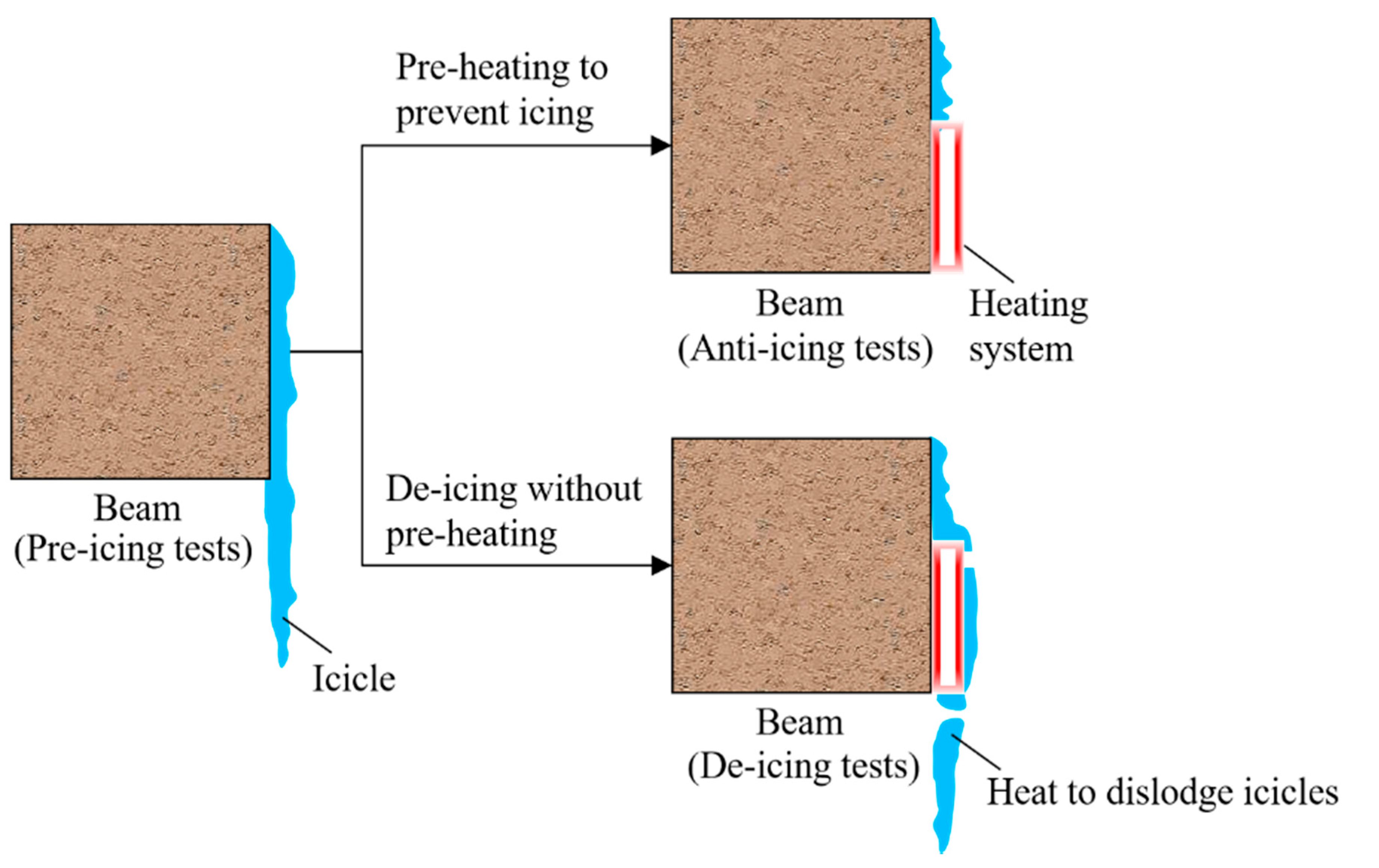
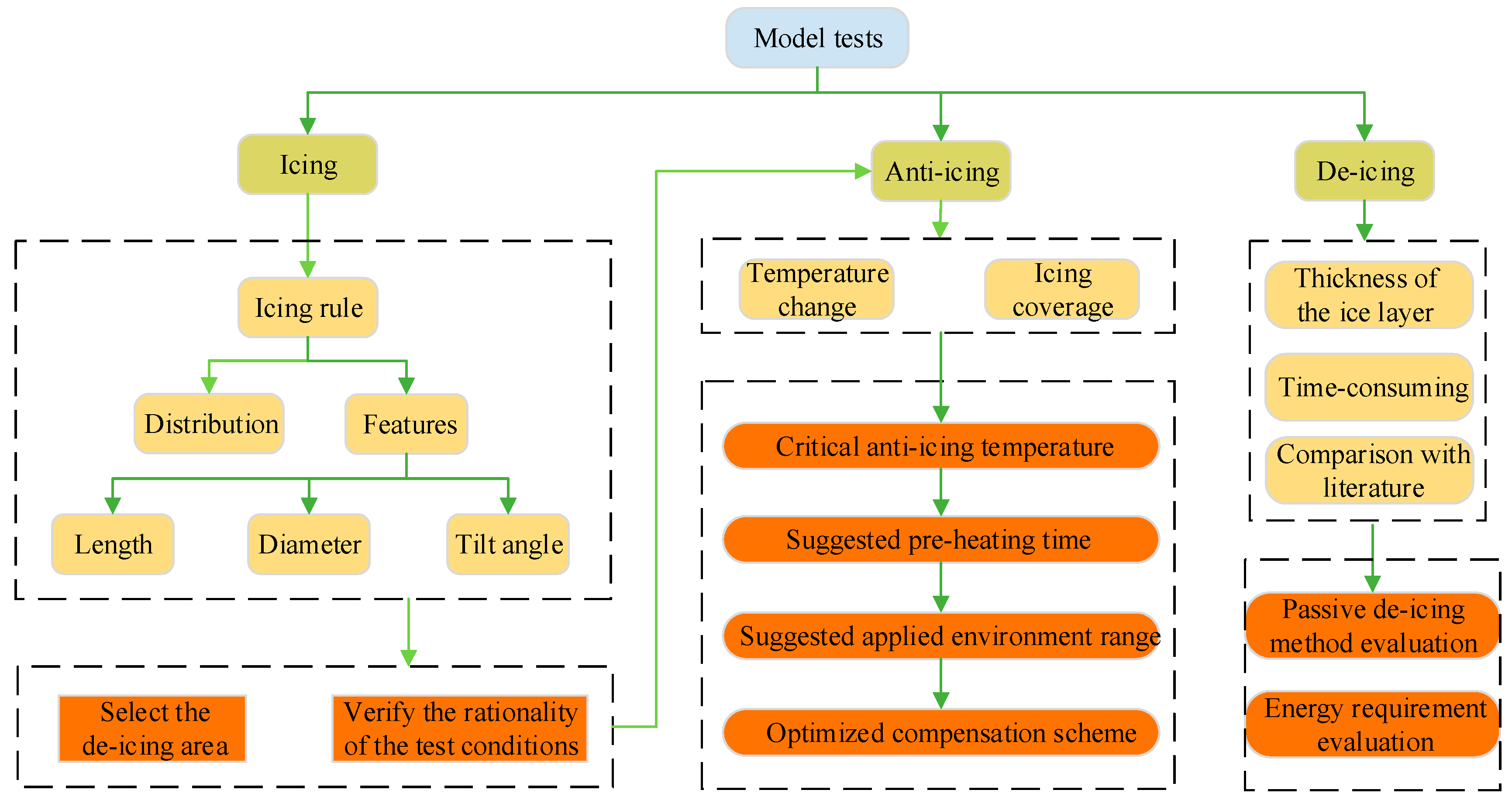
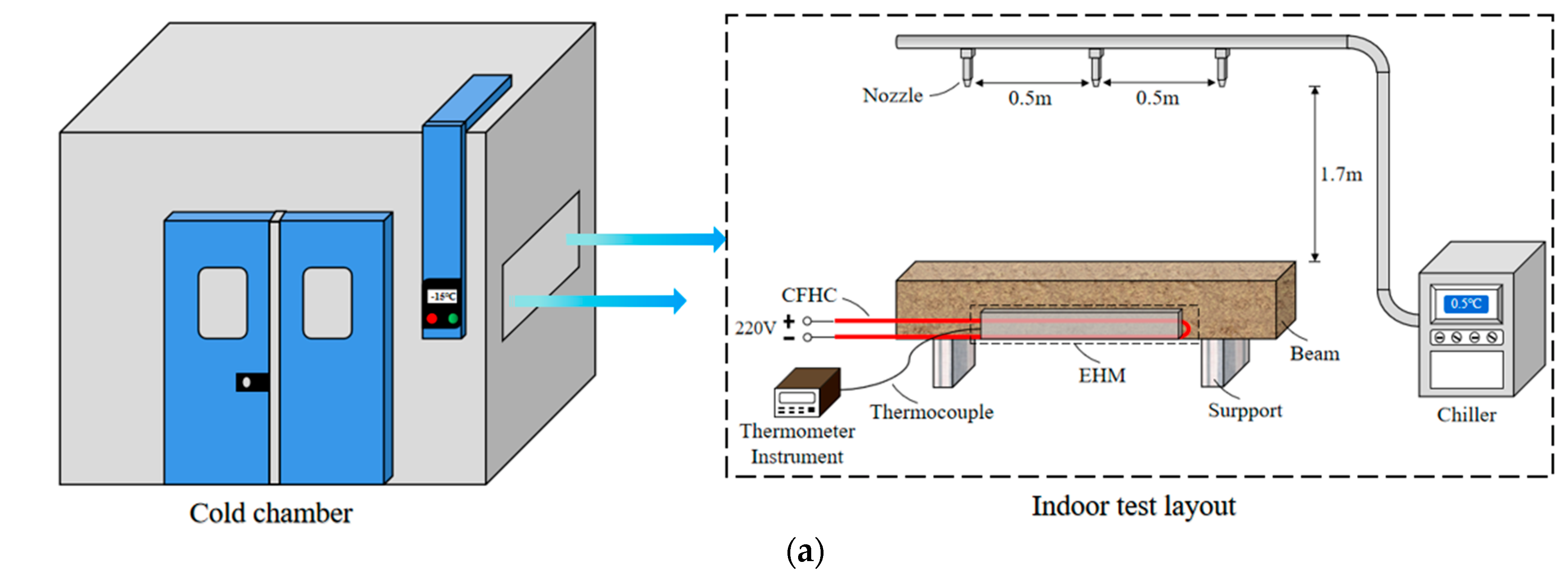



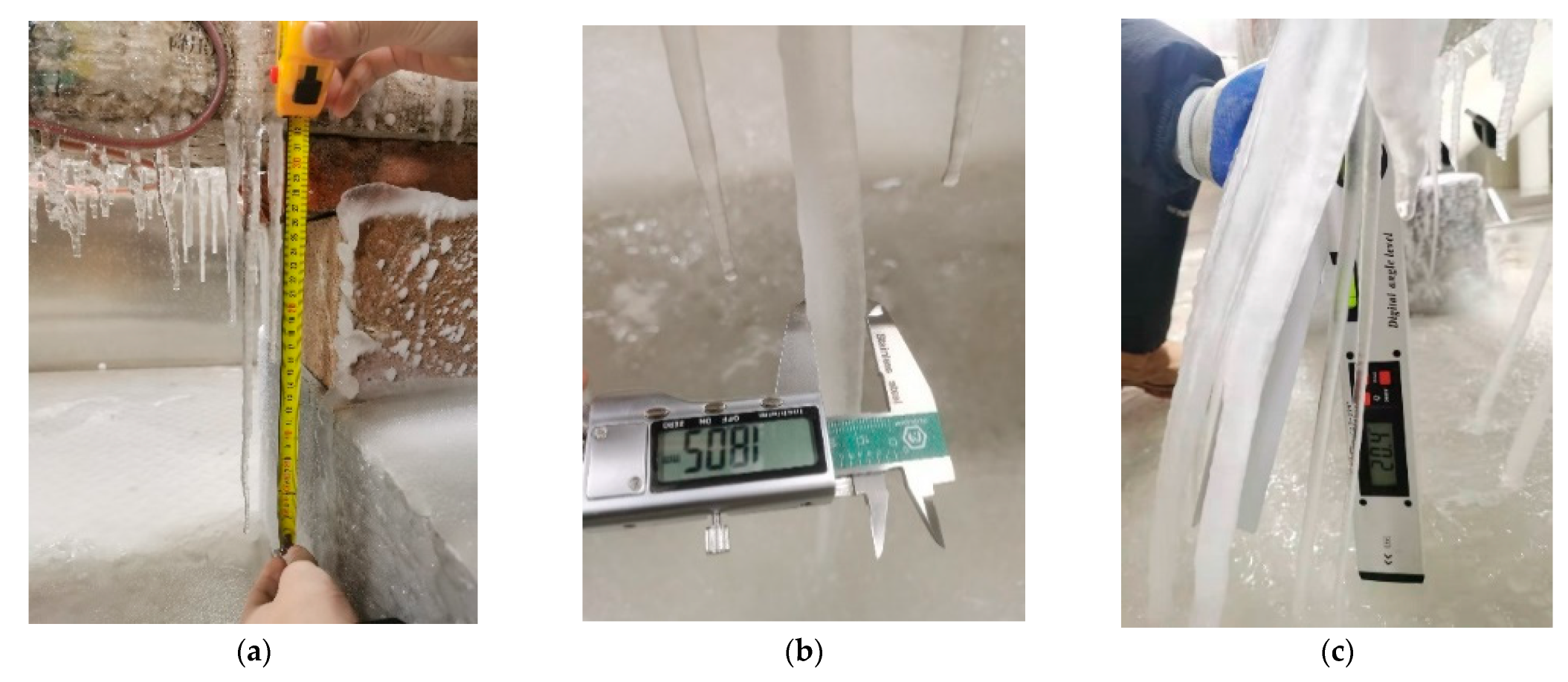
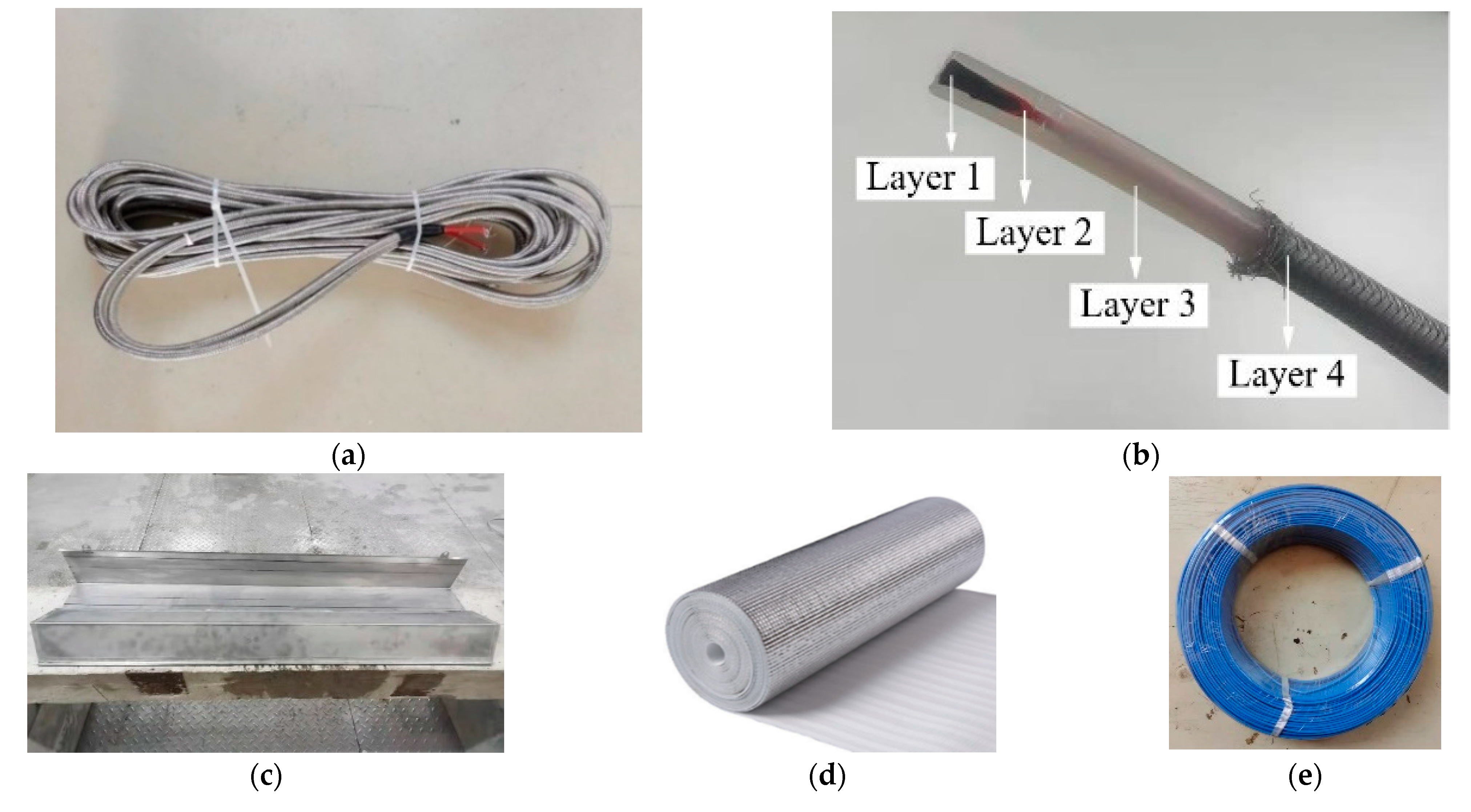


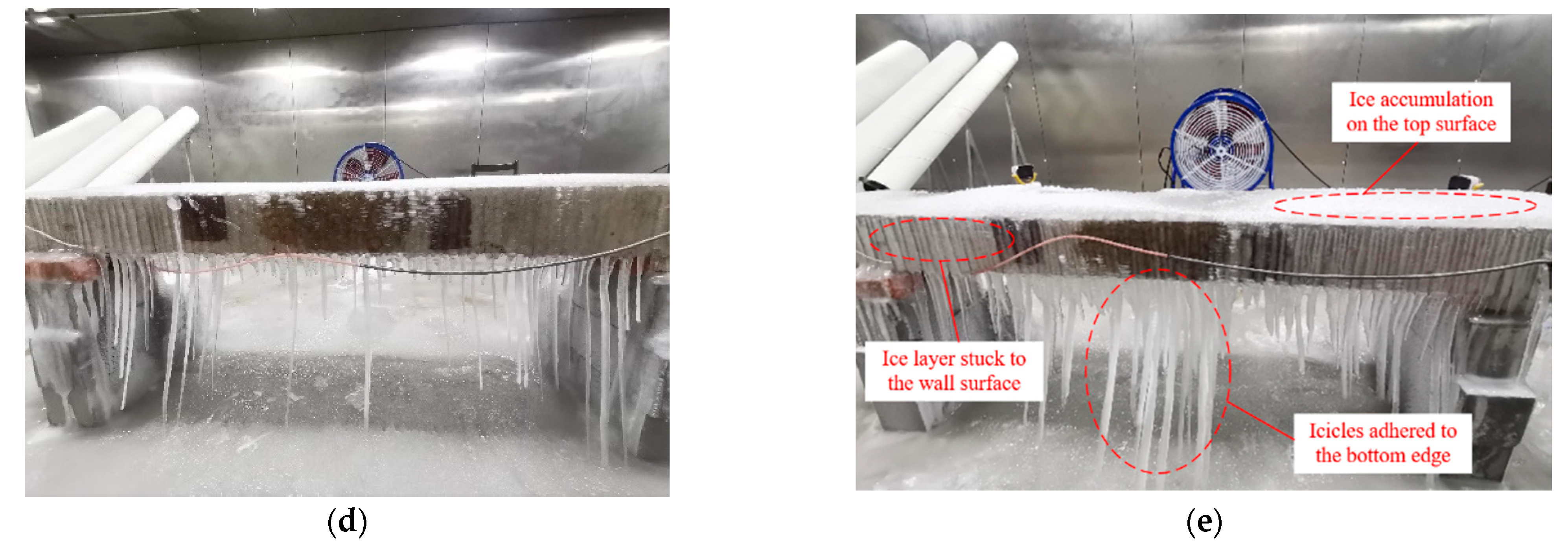

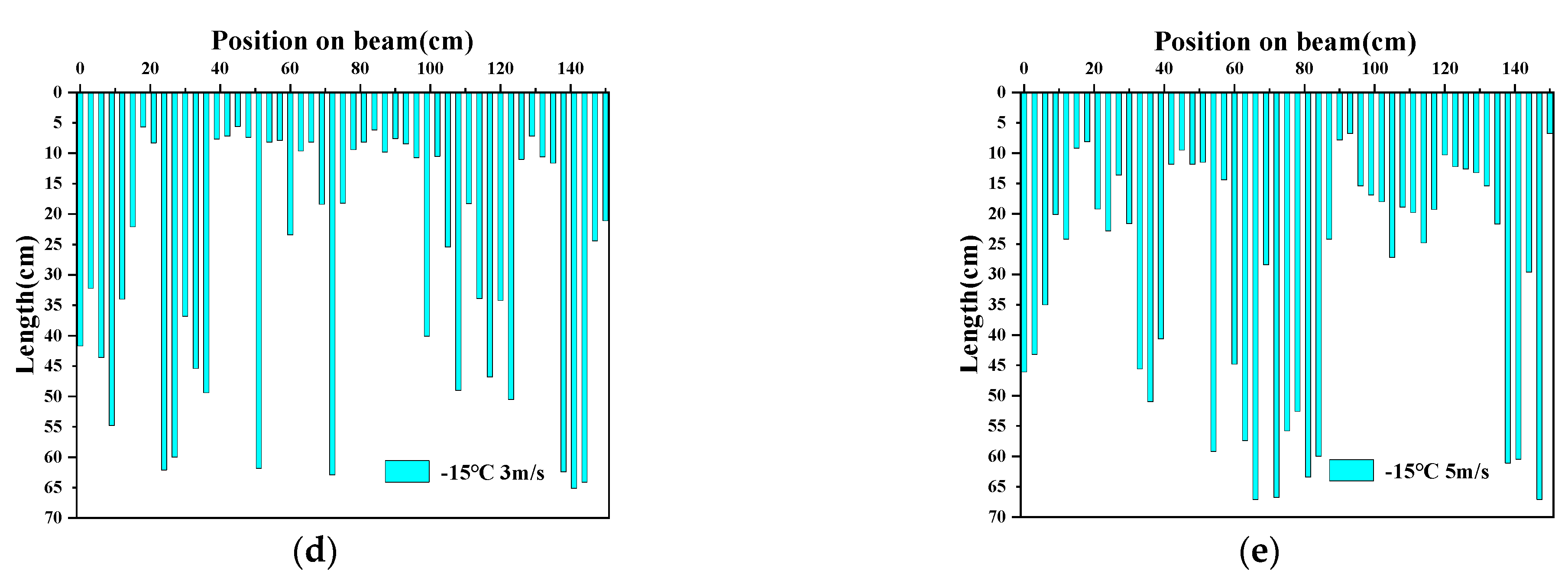
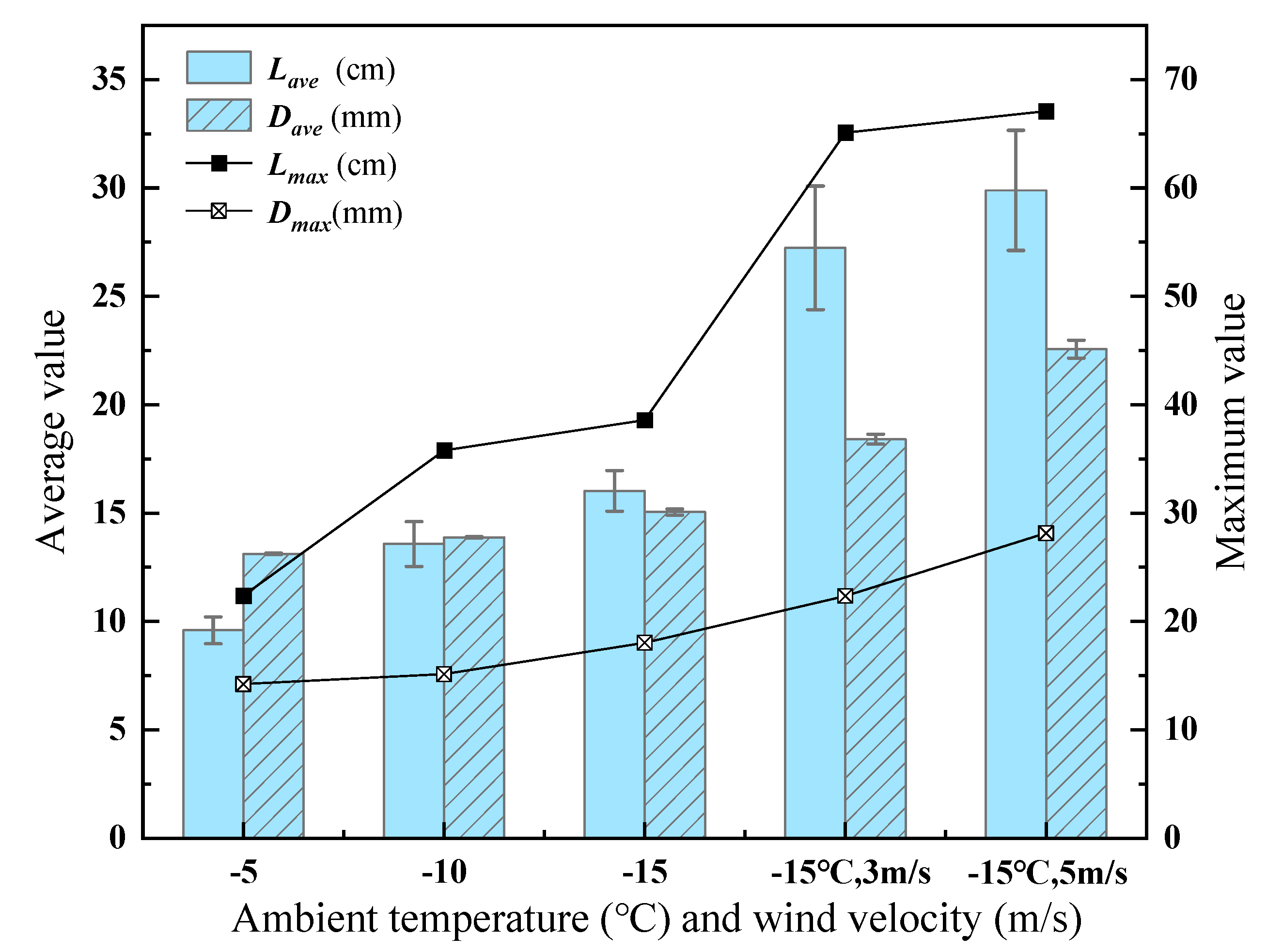
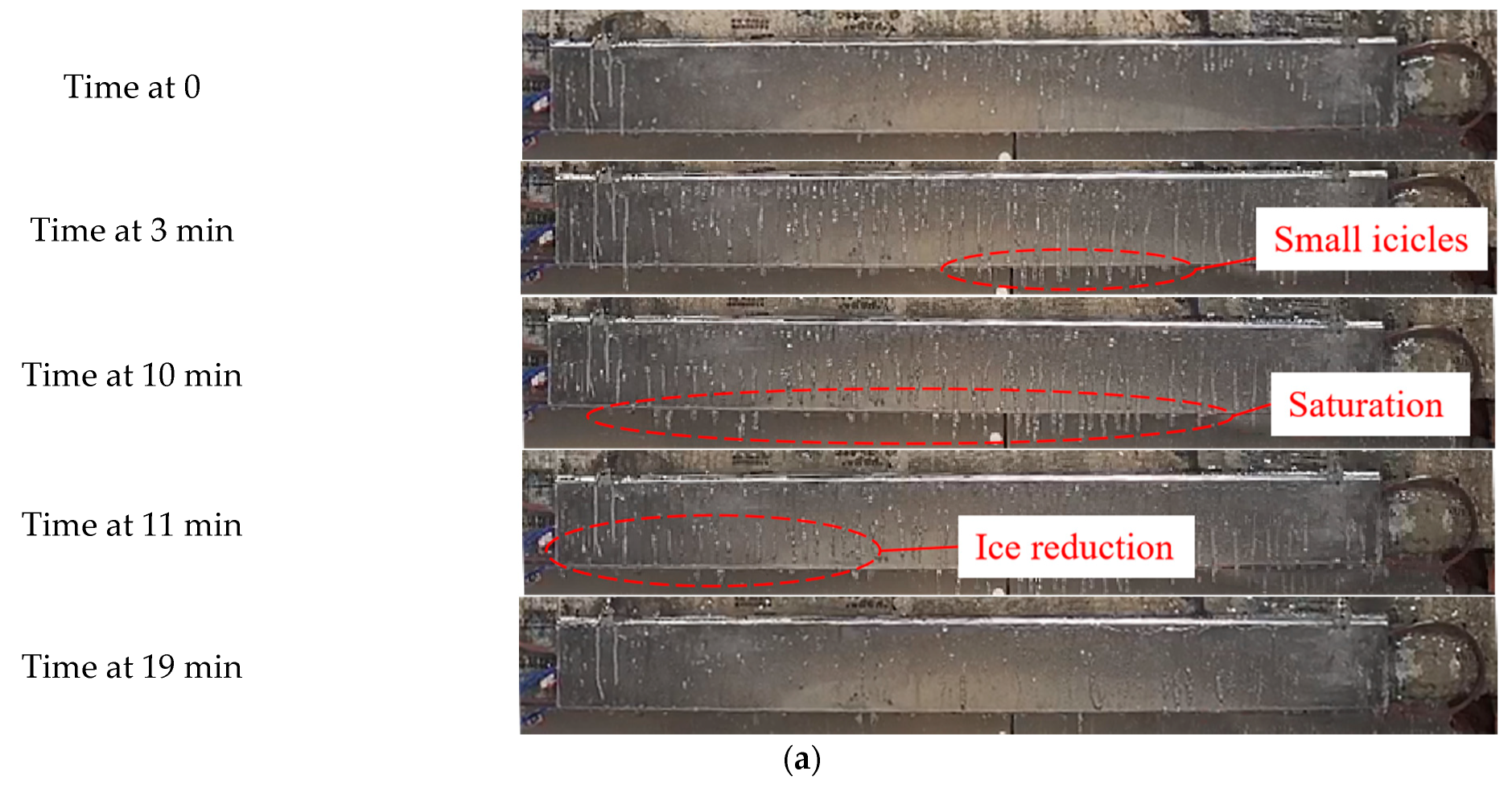
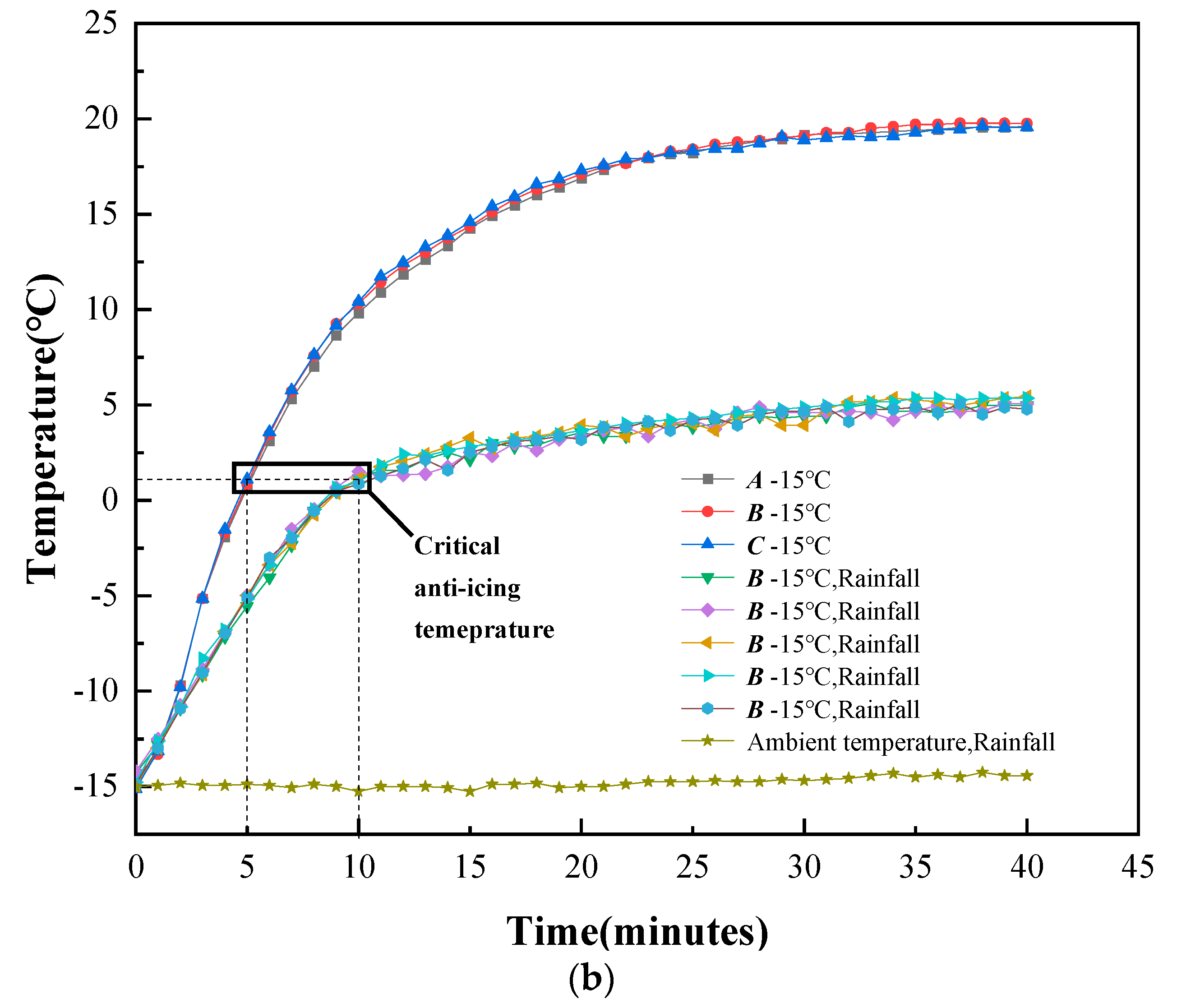
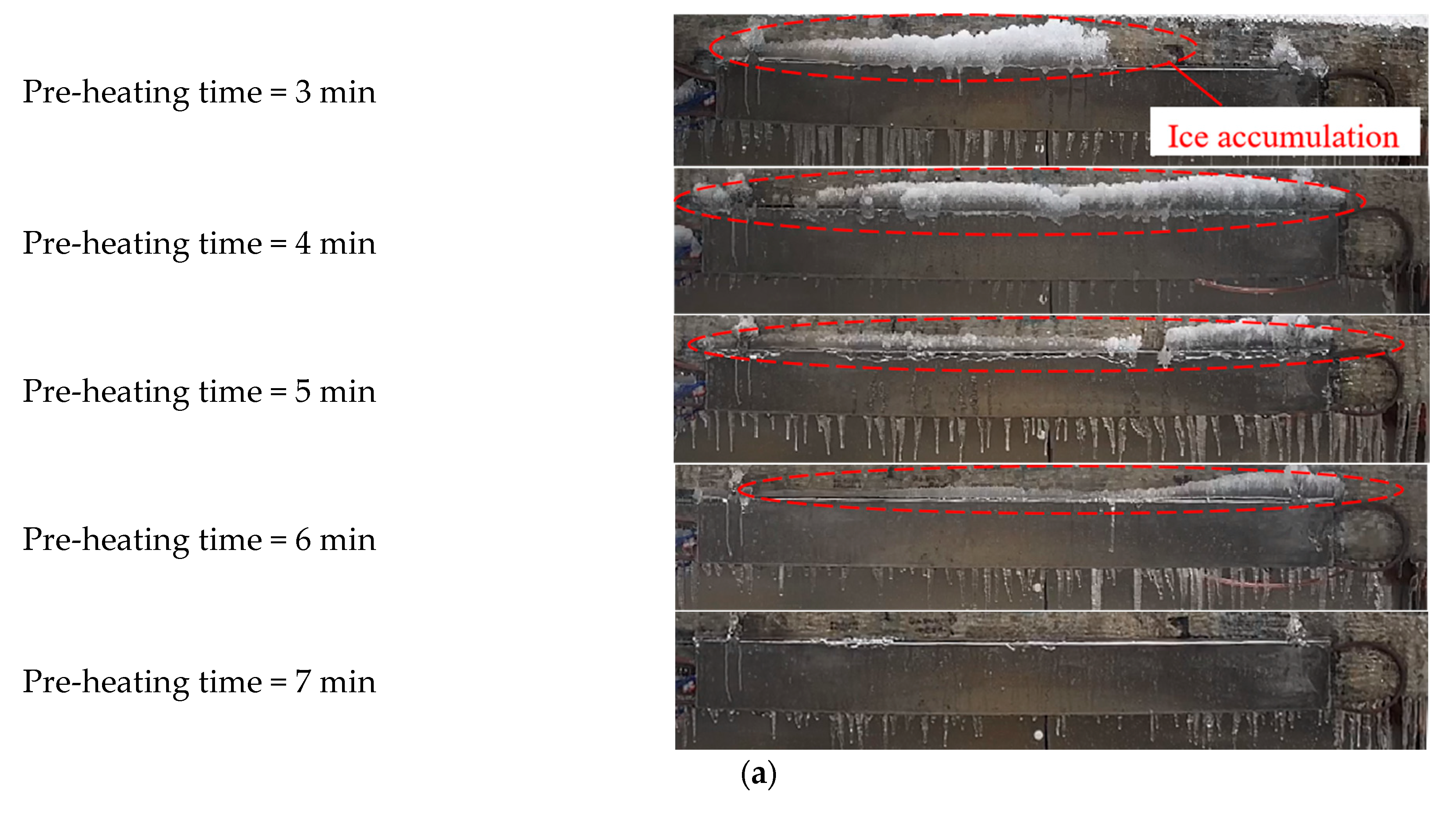
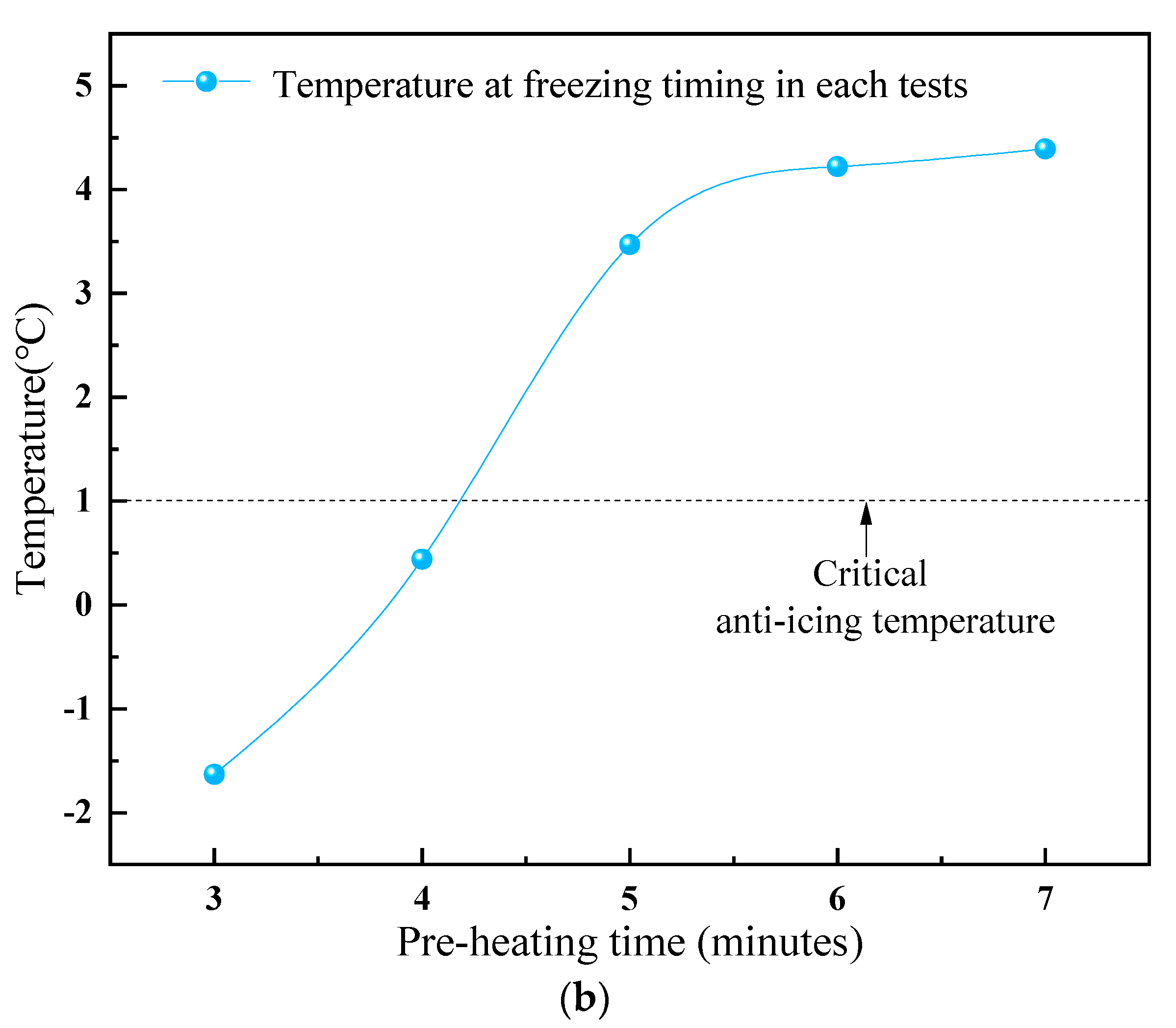
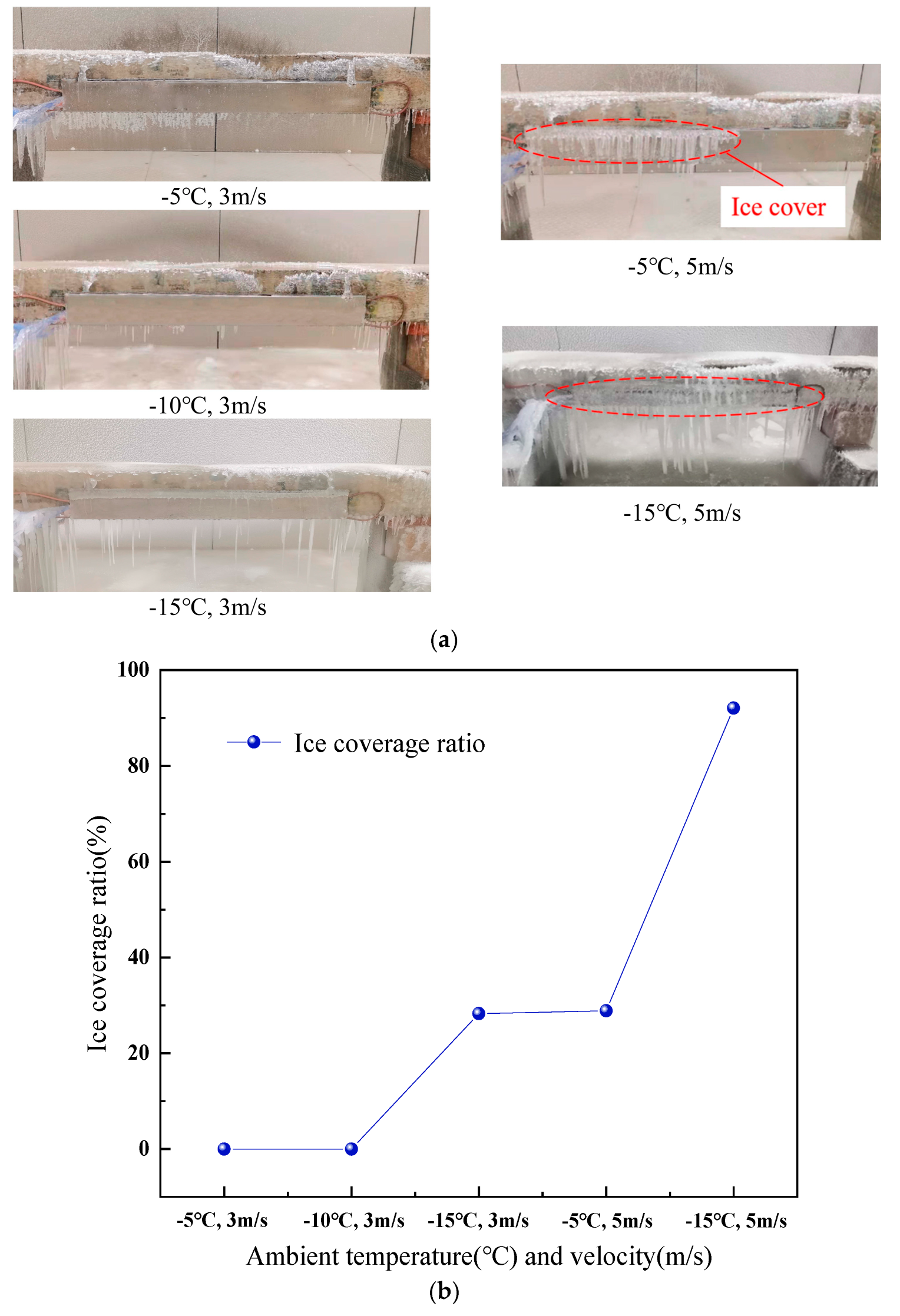
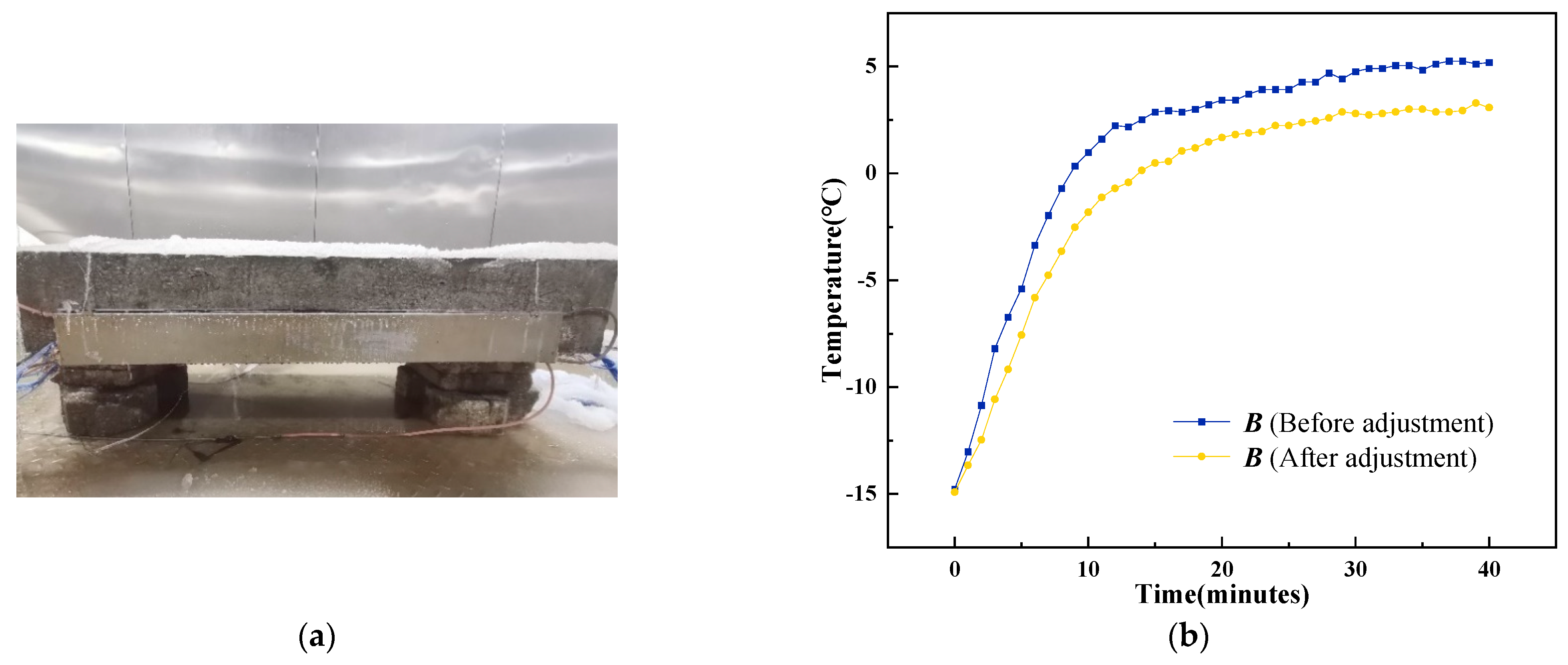
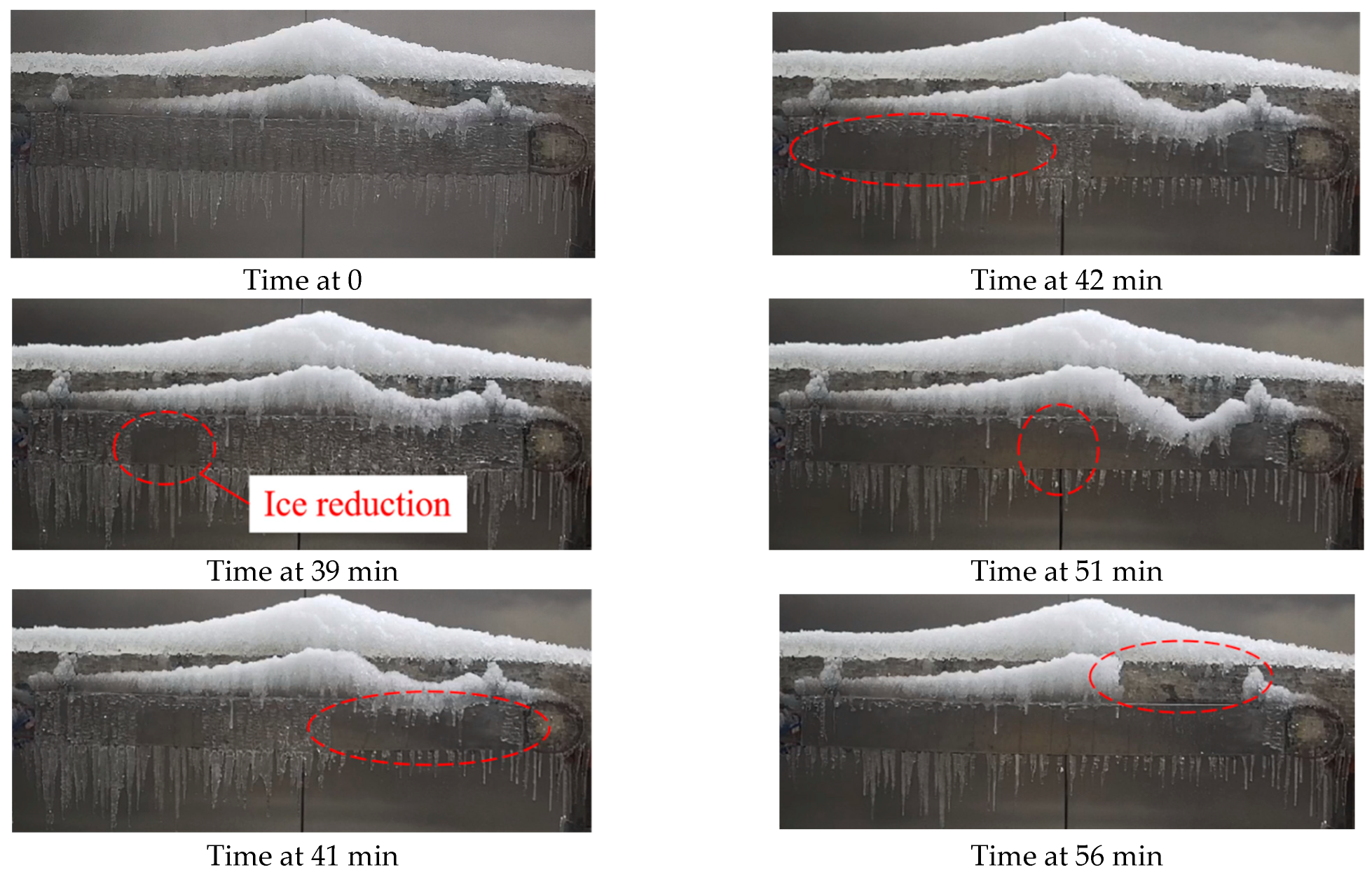
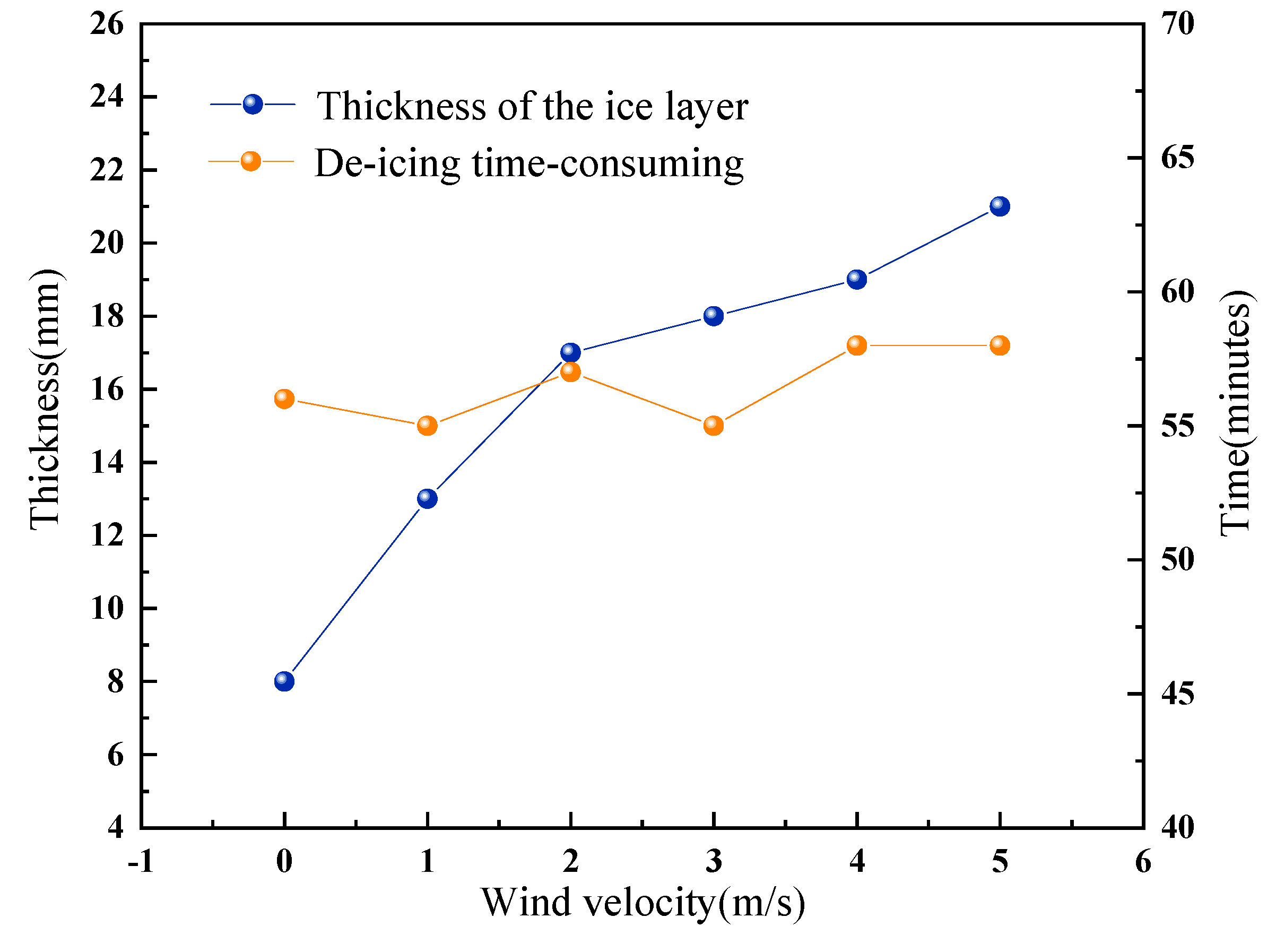
| Diameter | Resistance | Length | Power | Thermal Efficiency | Tensile Strength | Compressive Strength |
|---|---|---|---|---|---|---|
| 6 mm | ≈8.5 Ω·m−1 | 14 m | 28 W·m−1 | 98.2% | 40.41 MPa | 60.75 MPa |
| Group Number | Precipitation (mm/min) | Ambient Temperature (°C) | Wind Velocity (m/s) |
|---|---|---|---|
| 1 | 1 | −5 | 0 |
| 2 | 1 | −10 | 0 |
| 3 | 1 | −15 | 0 |
| 4 | 1 | −15 | 3 |
| 5 | 1 | −15 | 5 |
| Test Conditions | Lmax/(cm) | Lave/(cm) | SE of Lave | Dmax/(mm) | Dave/(mm) | SE of Lave | θ/(°) |
|---|---|---|---|---|---|---|---|
| −5 °C | 22.4 | 9.59 | 0.62 | 14.23 | 13.12 | 0.03 | 0 |
| −10 °C | 35.8 | 13.58 | 1.03 | 15.14 | 13.88 | 0.03 | 0 |
| −15 °C | 38.6 | 16.02 | 0.94 | 18.05 | 15.05 | 0.14 | 0 |
| −15 °C, 3 m/s | 65.1 | 26.44 | 2.85 | 22.34 | 18.41 | 0.23 | 20.4 |
| −15 °C, 5 m/s | 67.1 | 29.89 | 2.77 | 28.17 | 22.56 | 0.41 | 22.7 |
| Group Number | Ambient Temperature /(°C) | Wind Velocity /(m/s) | Pre-Heating Time /(min) | Precipitation /(mm/min) | Ice Coverage Ratio |
|---|---|---|---|---|---|
| 1 | −5 | 3 | 40 | 1 | 0% |
| 2 | −10 | 3 | 40 | 1 | 0% |
| 3 | −15 | 3 | 40 | 1 | 28.27% |
| 4 | −5 | 5 | 40 | 1 | 28.88% |
| 5 | −15 | 5 | 40 | 1 | 92.07% |
| Group Number | Ambient Temperature /(°C) | Wind Velocity /(m/s) | Thickness of the Ice Layer /(mm) | De-Icing Time Period /(min) |
|---|---|---|---|---|
| 1 | −15 | 0 | 8 | 56 |
| 2 | −15 | 1 | 13 | 55 |
| 3 | −15 | 2 | 17 | 57 |
| 4 | −15 | 3 | 18 | 55 |
| 5 | −15 | 4 | 19 | 58 |
| 6 | −15 | 5 | 21 | 58 |
Disclaimer/Publisher’s Note: The statements, opinions and data contained in all publications are solely those of the individual author(s) and contributor(s) and not of MDPI and/or the editor(s). MDPI and/or the editor(s) disclaim responsibility for any injury to people or property resulting from any ideas, methods, instructions or products referred to in the content. |
© 2023 by the authors. Licensee MDPI, Basel, Switzerland. This article is an open access article distributed under the terms and conditions of the Creative Commons Attribution (CC BY) license (https://creativecommons.org/licenses/by/4.0/).
Share and Cite
Yang, Z.; Bao, T.; Chen, Z.; Xiao, H.; Zhou, X.; Zhang, J.; Liu, Y. Model Experimental Study on De-Icing Method of Bridge Pylon Beam Based on Electric Heating. Appl. Sci. 2023, 13, 3793. https://doi.org/10.3390/app13063793
Yang Z, Bao T, Chen Z, Xiao H, Zhou X, Zhang J, Liu Y. Model Experimental Study on De-Icing Method of Bridge Pylon Beam Based on Electric Heating. Applied Sciences. 2023; 13(6):3793. https://doi.org/10.3390/app13063793
Chicago/Turabian StyleYang, Zhiyong, Tian Bao, Zhi Chen, Henglin Xiao, Xinlong Zhou, Jiacheng Zhang, and Yin Liu. 2023. "Model Experimental Study on De-Icing Method of Bridge Pylon Beam Based on Electric Heating" Applied Sciences 13, no. 6: 3793. https://doi.org/10.3390/app13063793
APA StyleYang, Z., Bao, T., Chen, Z., Xiao, H., Zhou, X., Zhang, J., & Liu, Y. (2023). Model Experimental Study on De-Icing Method of Bridge Pylon Beam Based on Electric Heating. Applied Sciences, 13(6), 3793. https://doi.org/10.3390/app13063793





